Hydrodynamic and Climatic Effects on an Amazon Beach Under Unplanned Occupation: A Case Study
Abstract
1. Introduction
2. Materials and Methods
2.1. Study Area
2.2. Methodology
3. Results
3.1. Forcing Mechanisms
3.2. In Situ Measurements
3.3. Shoreline Analysis
4. Discussion
5. Conclusions
Author Contributions
Funding
Data Availability Statement
Acknowledgments
Conflicts of Interest
References
- Aagaard, T. Modulation of surf zone processes on a barred beach due to changing water levels, Skalligen, Denmark. J. Coast. Res. 2002, 18, 25–38. [Google Scholar]
- Prasad, D.H.; Kumar, N.D. Coastal erosion studies—A review. Int. J. Geosci. 2014, 5, 341–345. [Google Scholar] [CrossRef]
- Vousdoukas, M.I.; Ranasinghe, R.; Mentaschi, L.; Plomaritis, T.A.; Athanasiou, P.; Luijendijk, A.; Feyen, L. Sandy coastlines under threat of erosion. Nat. Clim. Change 2020, 10, 260–263. [Google Scholar] [CrossRef]
- Short, A.D. Macro-meso tidal beach morphodynamics—An overview. J. Coast. Res. 1991, 7, 417–436. [Google Scholar]
- Levoy, F.; Monfort, O.; Larsonneur, C. Hydrodynamic variability on megatidal beaches, Normandy, France. Cont. Shelf Res. 2001, 21, 563–586. [Google Scholar] [CrossRef]
- Pranzini, E.; Williams, A.T. Coastal Erosion and Protection in Europe; Routledge: London, UK, 2013; p. 457. [Google Scholar]
- Mentaschi, L.; Vousdoukas, M.I.; Pekel, J.F.; Voukouvalas, E.; Feyen, L. Global long-term observations of coastal erosion and accretion. Sci. Rep. 2018, 8, 12876. [Google Scholar] [CrossRef]
- Wright, L.D.; Nielsen, P.; Short, A.D.; Greene, M.O. Morphodynamics of a macrotidal beach. Mar. Geol. 1982, 50, 97–128. [Google Scholar] [CrossRef]
- Masselink, G. Simulating the effects of tides on beach morphodynamics. J. Coast. Res. 1993, 15, 180–197. [Google Scholar]
- Anthony, E.J.; Gardel, A.; Gratiot, N.; Proisy, C.; Allison, M.A.; Dolique, F.; Fromard, F. The Amazon-influenced muddy coast of South America: A review of mud-bank–shoreline interactions. Earth Sci. Rev. 2010, 103, 99–121. [Google Scholar] [CrossRef]
- Pereira, L.C.C.; Vila-Concejo, A.; Trindade, W. Tidal modulation. In Sandy Beach Morphodynamics; Jackson, D.W.T., Short, A.D., Eds.; Elsevier: Amsterdam, The Netherlands, 2020; pp. 87–101. [Google Scholar] [CrossRef]
- Kroon, A.; Masselink, G. Morphodynamics of intertidal bar morphology on a macrotidal beach under low-energy wave conditions, North Lincolnshire, England. Mar. Geol. 2002, 190, 591–608. [Google Scholar] [CrossRef]
- Haquette, A.; Aernouts, D. The influence of nearshore sand bank dynamics on shoreline evolution in a macrotidal coastal environment, Calais, northern France. Cont. Shelf Res. 2010, 30, 1349–1361. [Google Scholar] [CrossRef]
- Idier, D.; Bertin, X.; Thompson, P.; Pickering, M.D. Interactions Between Mean Sea Level, Tide, Surge, Waves and Flooding: Mechanisms and Contributions to Sea Level Variations at the Coast. Surv. Geophys. 2019, 40, 1603–1630. [Google Scholar] [CrossRef]
- Souza-Filho, P.W.M.; Martins, E.d.S.F.; da Costa, F.R. Using mangroves as a geological indicator of coastal changes in the Bragança macrotidal flat, Brazilian Amazon: A remote sensing data approach. Ocean Coast. Manag. 2006, 49, 462–475. [Google Scholar] [CrossRef]
- Rodrigues, H.d.S.; de Lima, A.M.M.; Kuhn, P.A.F.; Rodrigues, H.J.B.; da Rocha, E.J.P. Economic vulnerability: Resulting from coastal erosion in Ajuruteua—Bragança/PA. Res. Soc. Dev. 2021, 10, e109101623822. [Google Scholar] [CrossRef]
- Teixeira, S.G.; Bandeira, I.C.N.; Dantas, M.E. Shoreline Variation and Identification of Local Erosion Geoindicators on the Brazilian Amazon Coast. J. Coast. Res. 2021, 37, 1088–1098. [Google Scholar] [CrossRef]
- Marengo, J.A.; Alves, L.M.; Soares, W.R.; Rodriguez, D.A.; Camargo, H.; Riveros, M.P.; Pabló, A.D. Two contrasting severe seasonal extremes in tropical South America in 2012: Flood in Amazonia and drought in northeast Brazil. J. Clim. 2013, 26, 9137–9154. [Google Scholar] [CrossRef]
- Marengo, J.A.; Borma, L.S.; Rodriguez, D.A.; Pinho, P.; Soares, W.R.; Alves, L.M. Recent extremes of drought and fooding in Amazonia: Vulnerabilities and human adaptation. Am. J. Clim. Change 2013, 2, 87–96. [Google Scholar] [CrossRef]
- Marengo, J.A.; Torres, R.R.; Alves, L.M. Drought in Northeast Brazil—Past, present, and future. Theor. Appl. Climatol. 2017, 129, 1189–1200. [Google Scholar] [CrossRef]
- Espinoza, J.C.; Marengo, J.A.; Schongart, J.; Jimenez, J.C. The new historical flood of 2021 in the Amazon River compared to major floods of the 21st century: Atmospheric features in the context of the intensification of floods. Weather Clim. Extrem. 2022, 35, 100406. [Google Scholar] [CrossRef]
- Cunha, A.P.; Zeri, M.; Deusdará Leal, K.R.; Costa, L.C.; Cuartas, L.A.; Marengo, J.A.; Tomasella, J.; Vieira, R.M.; Barbosa, A.A.; Cunningham, C.; et al. Extreme Drought Events over Brazil from 2011 to 2019. Atmosphere 2019, 10, 642. [Google Scholar] [CrossRef]
- da Costa, A.K.R.; Pereira, L.C.C.; Jiménez, J.A.; de Oliveira, A.R.G.; de Jesus Flores-Montes, M.; da Costa, R.M. Effects of Extreme Climatic Events on the Hydrological Parameters of the Estuarine Waters of the Amazon Coast. Estuar. Coast. 2022, 45, 1517–1533. [Google Scholar] [CrossRef]
- Pereira, L.C.C.; Guimarães, D.O.; Ribeiro, M.J.S.; Costa, R.M.; Souza-Filho, P.W.M. Use and occupation in Bragança littoral, Brazilian Amazon. J. Coast. Res. 2007, 50, 1116–1120. [Google Scholar] [CrossRef]
- Pereira, L.C.C.; Vila-Concejo, A.; Costa, R.M.; Short, A.D. Managing physical and anthropogenic hazards on macrotidal Amazon beaches. Ocean Coast. Manag. 2014, 96, 149–162. [Google Scholar] [CrossRef]
- Souza-Filho, P.W.M.; El-Robrini, M. Geomorphology of the Bragança coastal zone, northeastern Pará State. Rev. Bras. Geociênc. 2000, 30, 522–526. [Google Scholar] [CrossRef]
- Monteiro, M.C.; Pereira, L.C.C. Morphodynamic change of a macrotidal sand beach in the brazilian Amazon Coast (Ajuruteua—Pará). J. Coast. Res. 2009, 56, 103–107. [Google Scholar]
- Santos, P.B.M. Variabilidade Hidroclimática e Sua Relação com a Erosão Costeira na Praia de Ajuruteua (Bragança-PA). Trabalho de Conclusão de Curso (Graduação em Engenharia Ambiental e Energias Renováveis). Bachelor’s Thesis, Universidade Federal Rural da Amazônia, Belém, PA, Brazil, 2019. [Google Scholar]
- Cohen, M.C.L.; Lara, R.J.; Ramos, J.F.D.; Dittmar, T. Factors influencing the variability of Mg, Ca and K in waters of a mangrove creek in Bragança, North Brazil. Mangroves Salt Marshes 1999, 3, 9–15. [Google Scholar] [CrossRef]
- Menezes, M.P.M.; Berger, U.; Mehlig, U. Mangrove vegetation in Amazonia: A review of studies from the coast of Pará and Maranhão States, north Brazil. Acta Amaz. 2008, 38, 403–420. [Google Scholar] [CrossRef]
- Souza-Filho, P.W.M.; Paradell, W.R. Use of synthetic aperture radar for recognition of Coastal Geomorphological Features, land-use assessment, and shoreline changes in Bragança coast, Pará, Northern Brazil. Earth Sci. An. Acad. Bras. Ciênc. 2003, 75, 341–356. [Google Scholar] [CrossRef]
- INMET. Instituto Nacional de Meteorologia. Monitoramento das Estações Automáticas. 2024. Available online: https://portal.inmet.gov.br/dadoshistoricos (accessed on 30 November 2024).
- CHN. Centro de Hidrografia e Navegação Marinha do Brasil. 2024. Available online: https://www.marinha.mil.br/dhn/ (accessed on 30 November 2024).
- Pereira, L.C.C.; Vila-Concejo, A.; Short, A.D. Influence of subtidal sand banks on tidal modulation of waves and beach morphology in Amazon macrotidal beaches. J. Coast. Res. 2013, 65, 1821–1826. [Google Scholar] [CrossRef]
- Golden Gate Weather Services. 2024. Available online: https://ggweather.com/enso/oni.htm (accessed on 30 November 2024).
- ANA. Agência Nacional de águas. 2024. Available online: https://www.gov.br/ana/pt-br (accessed on 30 November 2024).
- Martorano, L.G.; Pereira, L.C.; Cezar, E.G.M.; Pereira, I.C.B. Estudos Climáticos do Estado do Pará, Classificação Climática (Köppen) e Deficiência Hídrica (Thornthwhite, Mather); SUDAM/EMBRAPA, SNLCS: Belém, PA, Brazil, 1993. [Google Scholar]
- Silva, B.R.P.; Pereira, L.C.C.; Vila-Concejo, A.; Costa, R.M. Effects of rainfall patterns on the trophic conditions of a near-pristine Amazon estuary (Brazil). Reg. Stud. Mar. Sci. 2025, 1, 10410. [Google Scholar] [CrossRef]
- Marengo, J.A.; Tomasella, J.; Alves, L.M.; Soares, W.R.; Rodriguez, D.A. The drought of 2010 in the context of historical droughts in the Amazon región. Geophys. Res. Lett. 2011, 38, L12703. [Google Scholar] [CrossRef]
- Marengo, J.A.; Williams, E.R.; Alves, L.M.; Soares, W.R.; Rodriguez, D.A. Extreme Seasonal Climate Variations in the Amazon Basin: Droughts and Floods. In Interactions Between Biosphere, Atmosphere and Human Land Use in the Amazon Basin; Nagy, L., Forsberg, B., Artaxo, P., Eds.; Ecological Studies; Springer: Berlin/Heidelberg, Germany, 2016; pp. 55–76. [Google Scholar] [CrossRef]
- Barnard, P.L.; Hoover, D.; Hubbard, D.M.; Snyder, A.; Ludka, B.C.; Allan, J.; Serafin, K.A. Extreme oceanographic forcing and coastal response due to the 2015–2016 El Niño. Nat. Commun. 2017, 8, 14365. [Google Scholar] [CrossRef]
- Yang, B.C.; Dalrymple, R.W.; Chun, S.S.; Lee, H.J. Transgressive sedimentation and stratigraphic evolution of a wave-dominated macrotidal coast, western Korea. Mar. Geol. 2006, 235, 35–48. [Google Scholar] [CrossRef]
- Levoy, F.; Monfort, O.; Anthony, E.J. Multi-decadal shoreline mobility of a managed sandy tidal coast (Normandy, France): Behavioural variability in a context of sea-level rise and increasing storm intensity. Reg. Stud. Mar. Sci. 2023, 62, 102973. [Google Scholar] [CrossRef]
- Rodrigues, H.D.S. Análise de Perdas Econômicas Geradas Pela Erosão em Ambiente Praiano: Caso da Praia de Ajuruteua–Bragança/PA. Master’s Thesis, Federal University of Pará, Belém, PA, Brazil, 2018. [Google Scholar]
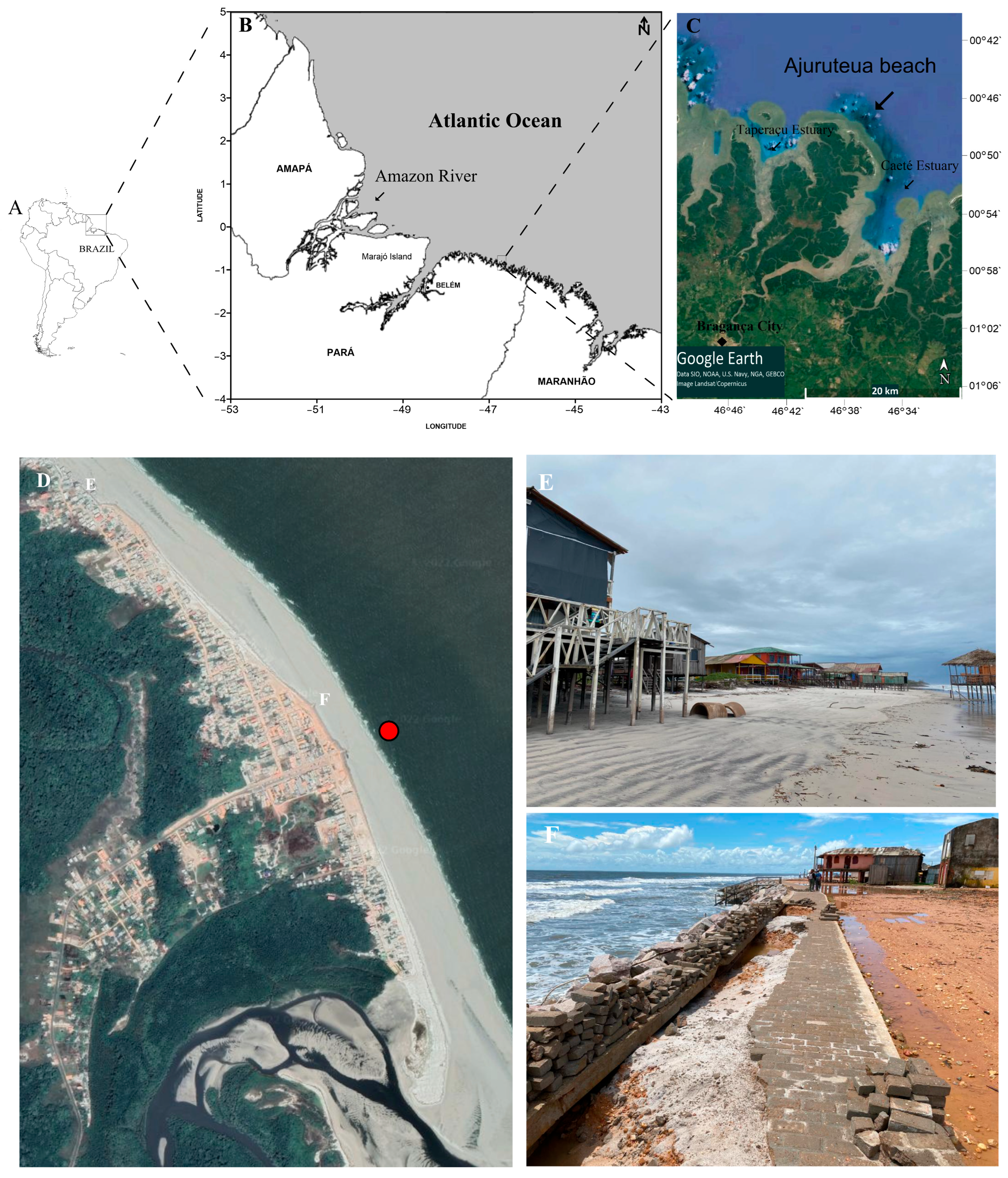
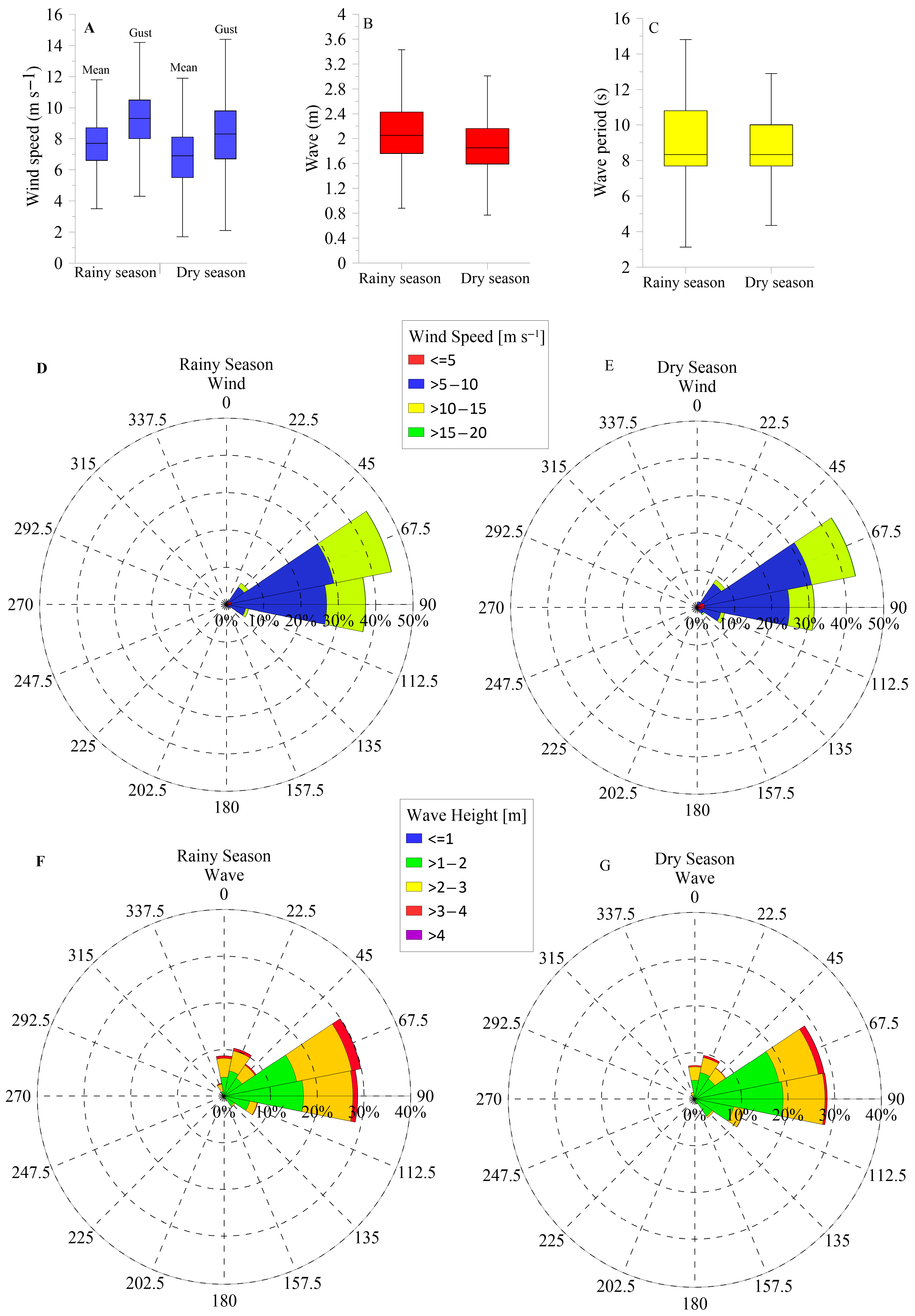
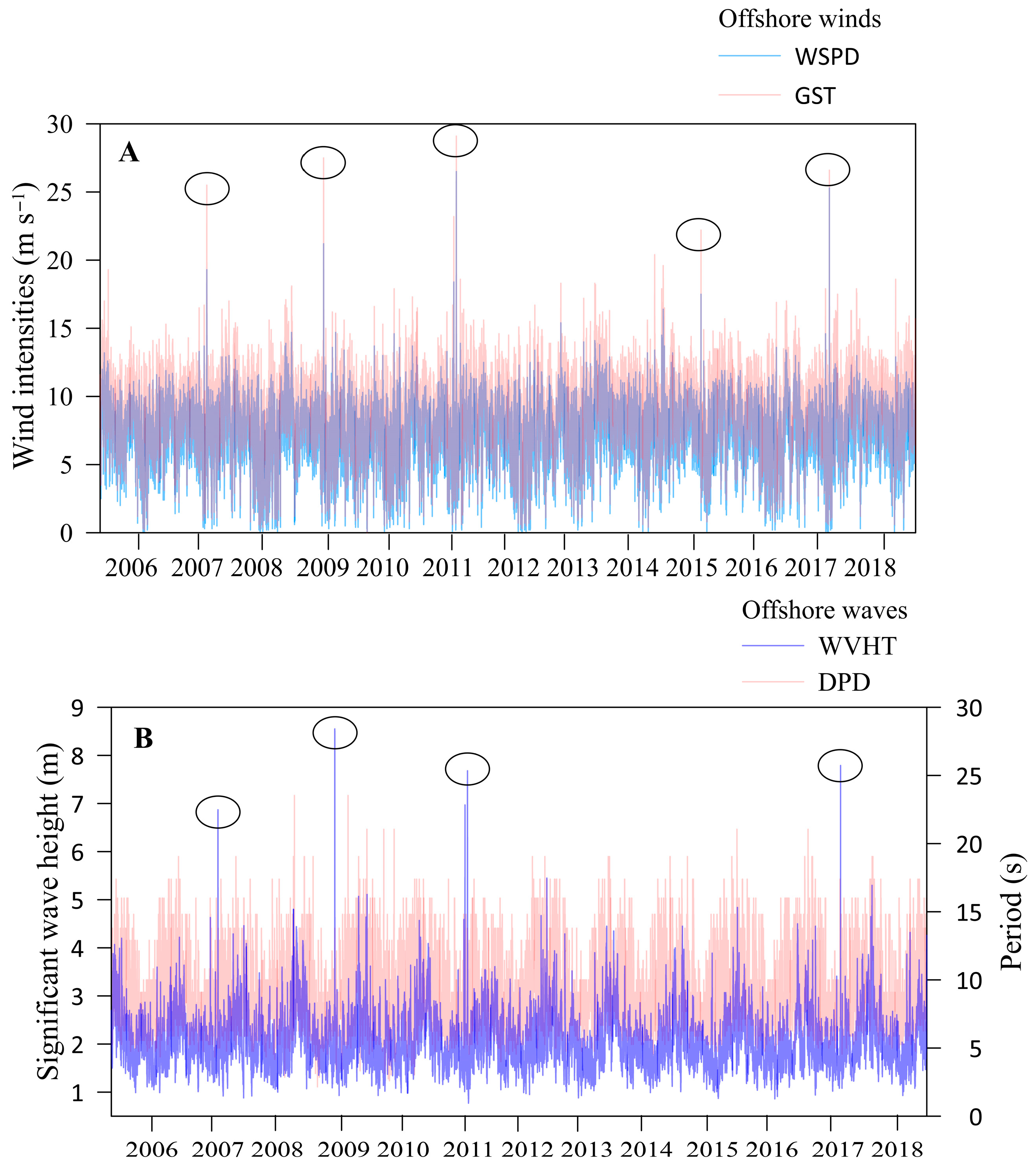
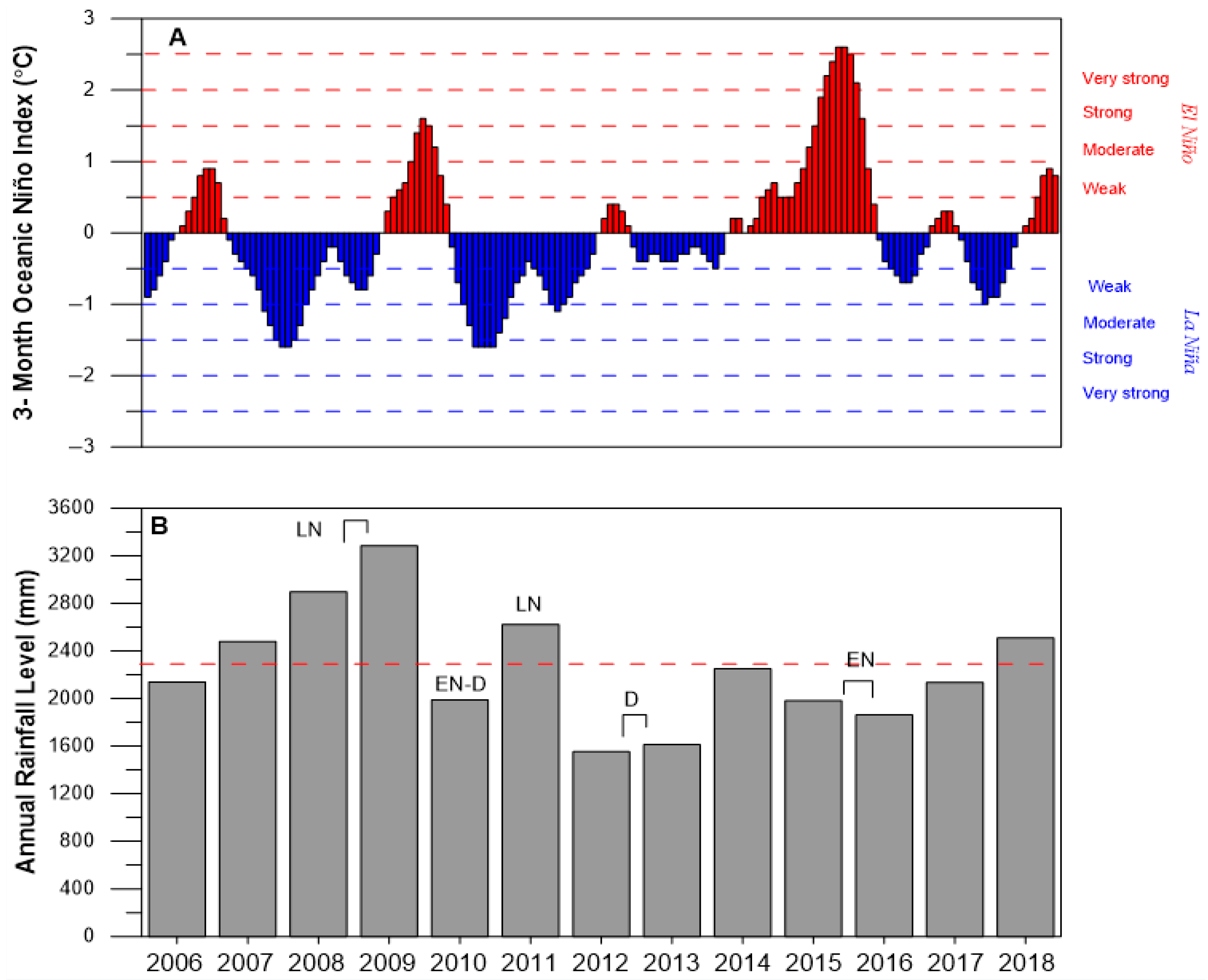
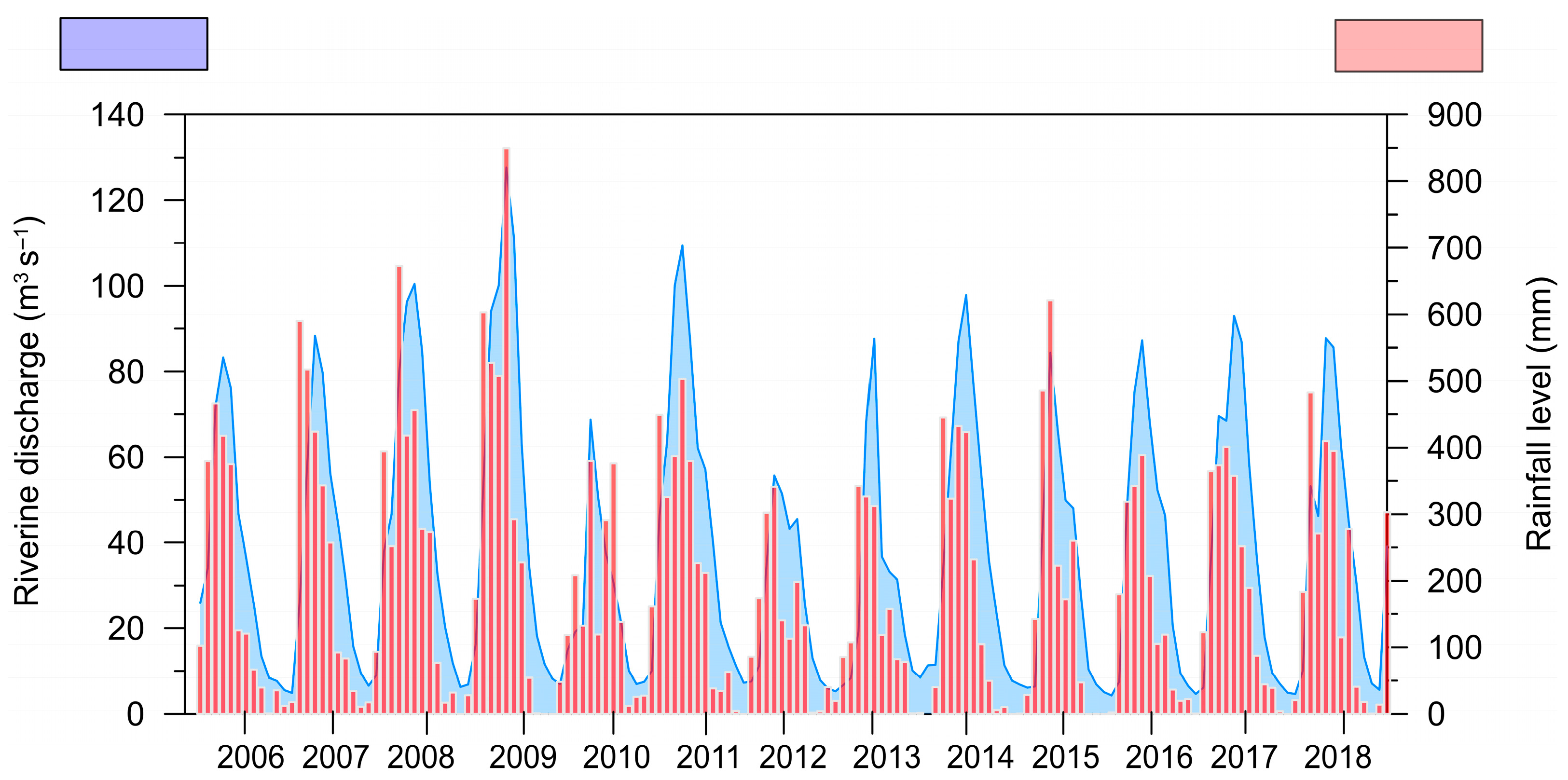
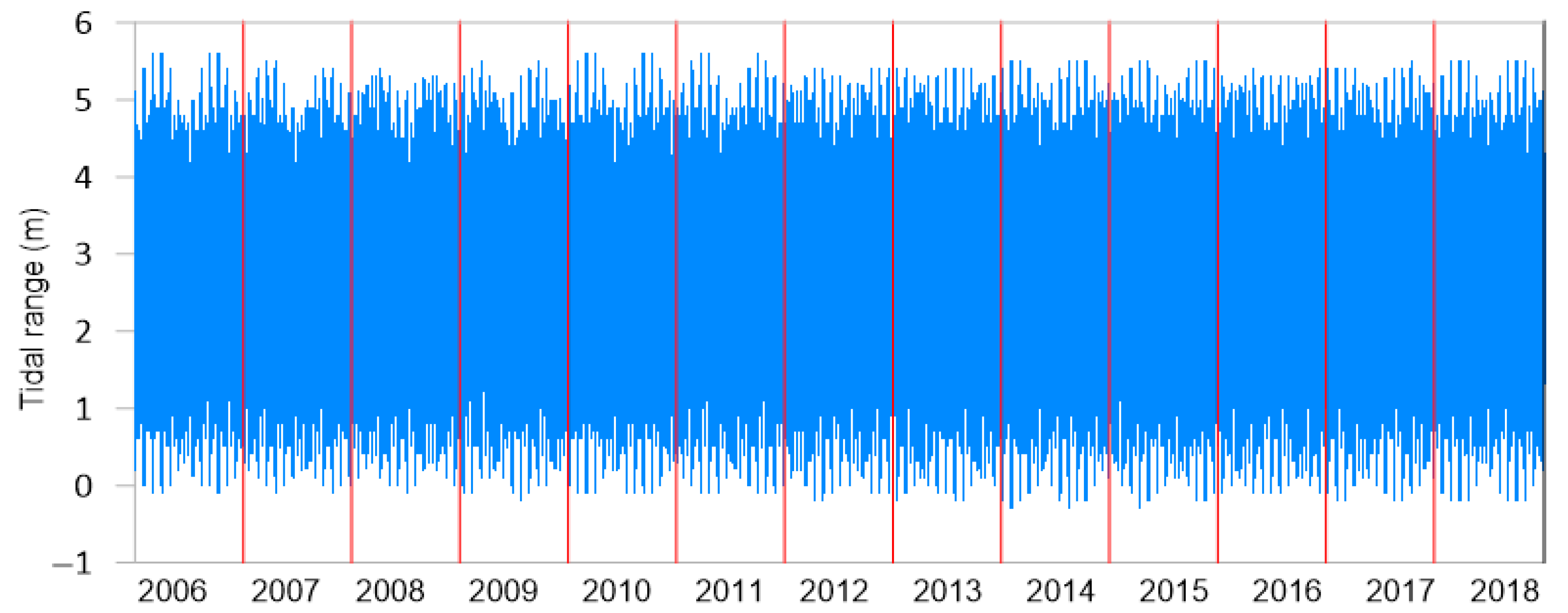
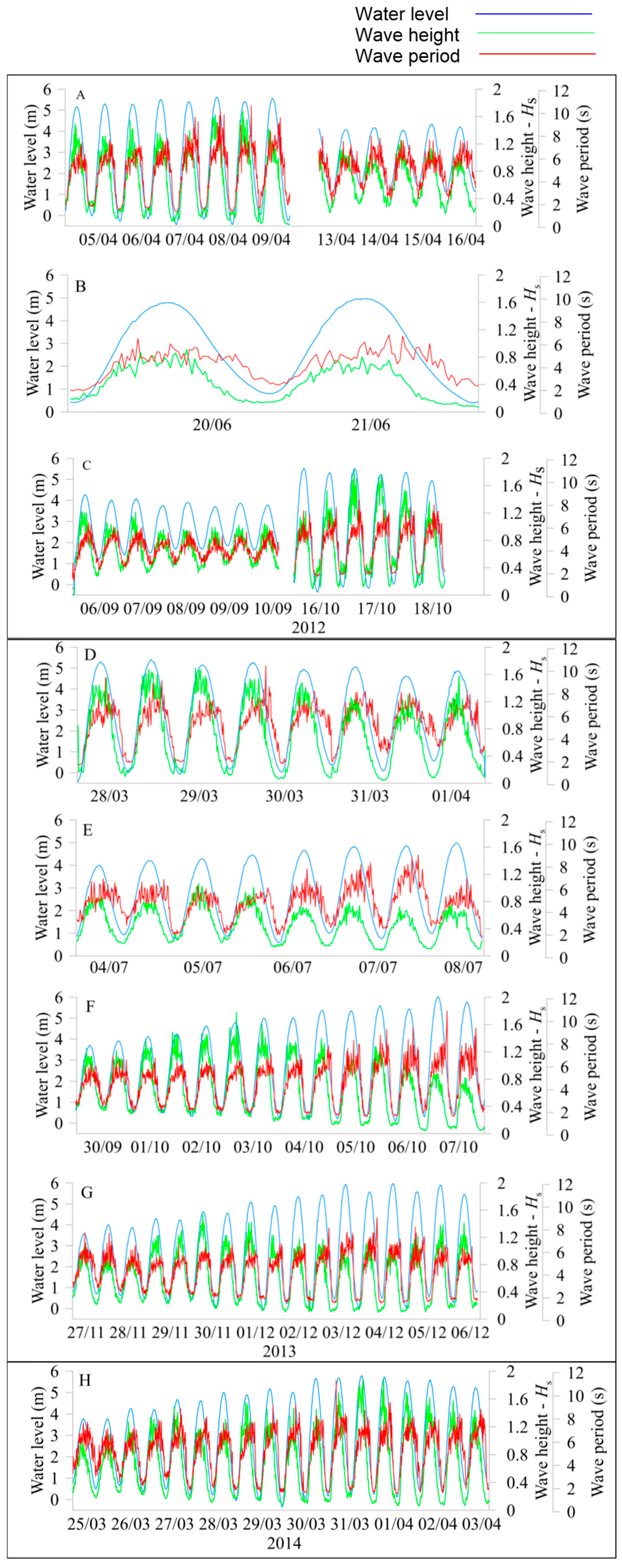
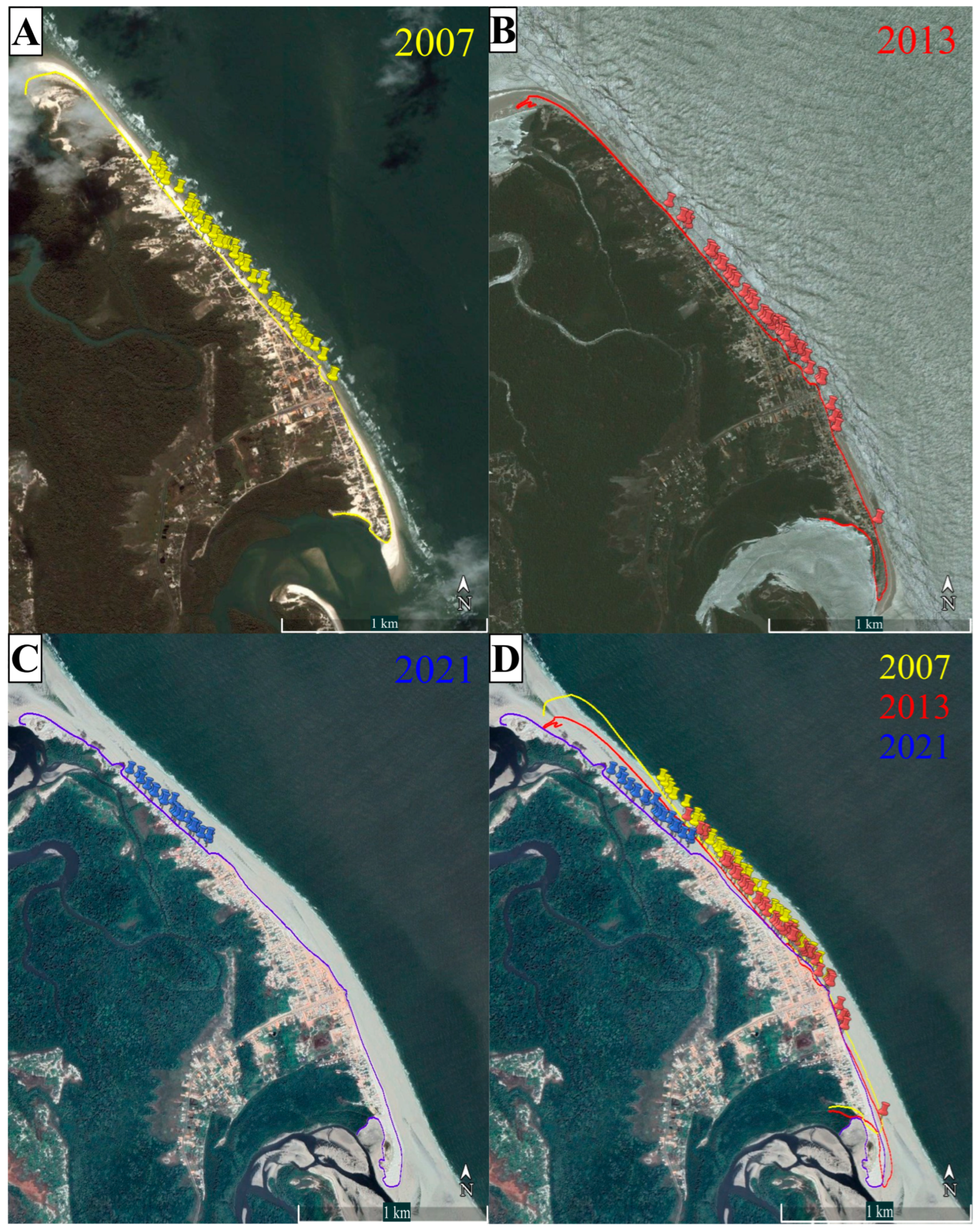
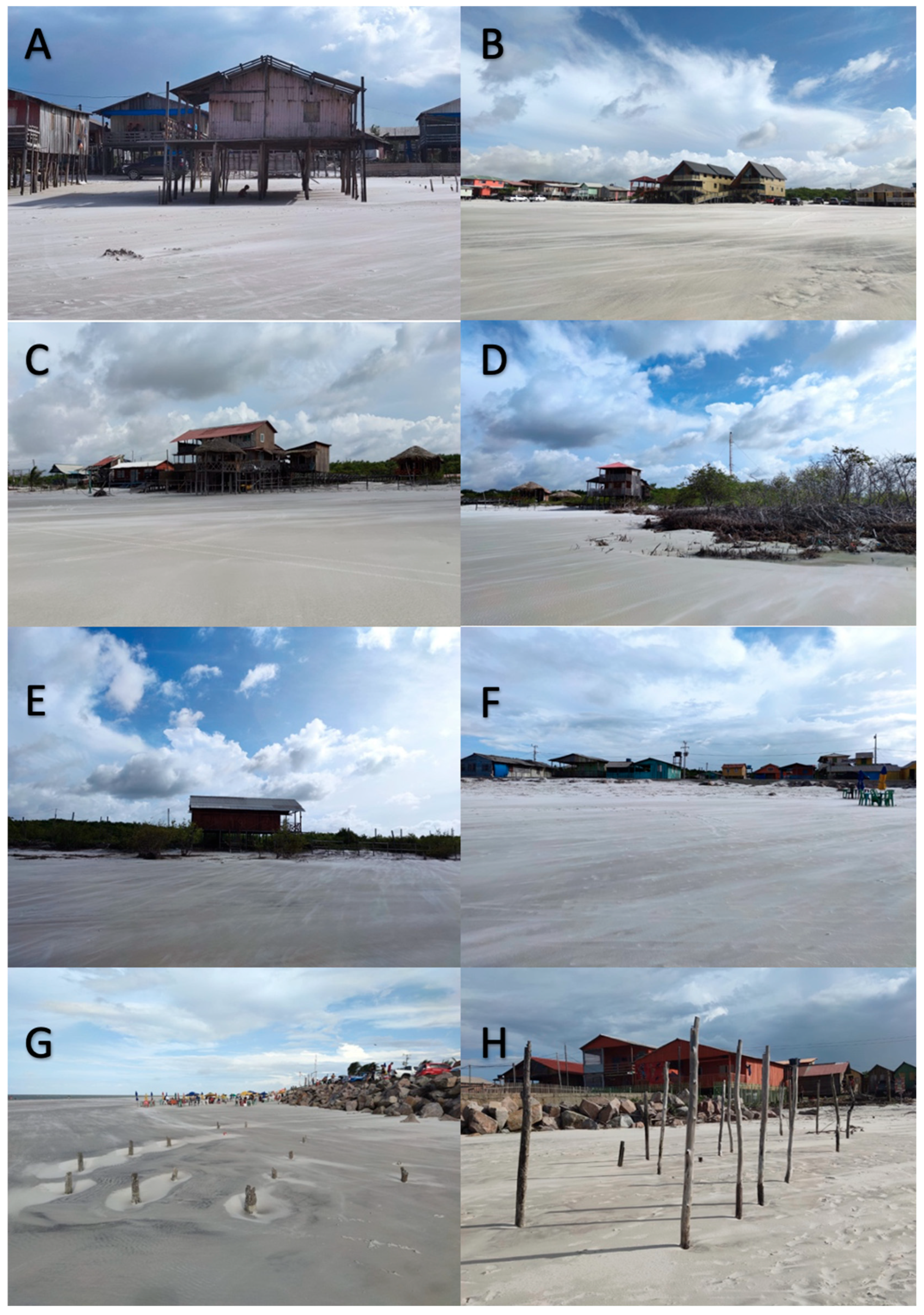
| Season | Natural Conditions and Months |
|---|---|
| Rainy | - When river discharge begins to rise and aligns with equinoctial tides, it typically occurs during March and April. |
| - When the peak of river discharge reaches its highest values, it typically occurs during May and June. | |
| Dry | - When river discharge decreases and aligns with equinoctial tides, this typically occurs in September and October. |
| - When local river discharge reaches its lowest levels, it is usually observed in November and December. |
| Features | 2007–2013 | 2013–2021 | 2007–2021 |
|---|---|---|---|
| Area | 0.12 km2 | 0.03 km2 | 0.15 km2 |
| Maximal beach retreat | 0.245 km | 0.119 km | 0.360 km |
Disclaimer/Publisher’s Note: The statements, opinions and data contained in all publications are solely those of the individual author(s) and contributor(s) and not of MDPI and/or the editor(s). MDPI and/or the editor(s) disclaim responsibility for any injury to people or property resulting from any ideas, methods, instructions or products referred to in the content. |
© 2025 by the authors. Licensee MDPI, Basel, Switzerland. This article is an open access article distributed under the terms and conditions of the Creative Commons Attribution (CC BY) license (https://creativecommons.org/licenses/by/4.0/).
Share and Cite
Pereira, R.L.M.d.C.; Pereira, L.C.C.; Mosso, C. Hydrodynamic and Climatic Effects on an Amazon Beach Under Unplanned Occupation: A Case Study. Coasts 2025, 5, 29. https://doi.org/10.3390/coasts5030029
Pereira RLMdC, Pereira LCC, Mosso C. Hydrodynamic and Climatic Effects on an Amazon Beach Under Unplanned Occupation: A Case Study. Coasts. 2025; 5(3):29. https://doi.org/10.3390/coasts5030029
Chicago/Turabian StylePereira, Remo Luan Marinho da Costa, Luci Cajueiro Carneiro Pereira, and Cesar Mosso. 2025. "Hydrodynamic and Climatic Effects on an Amazon Beach Under Unplanned Occupation: A Case Study" Coasts 5, no. 3: 29. https://doi.org/10.3390/coasts5030029
APA StylePereira, R. L. M. d. C., Pereira, L. C. C., & Mosso, C. (2025). Hydrodynamic and Climatic Effects on an Amazon Beach Under Unplanned Occupation: A Case Study. Coasts, 5(3), 29. https://doi.org/10.3390/coasts5030029







